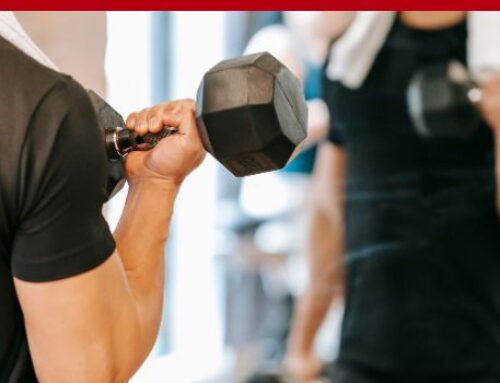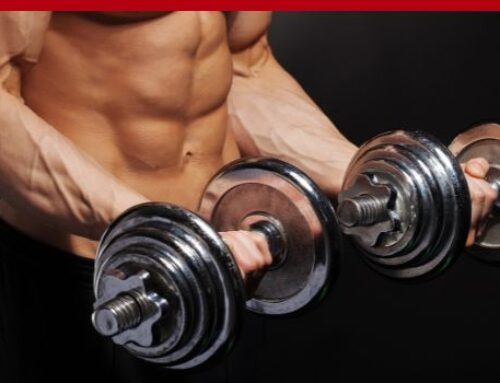
271: 5 Training Techniques That Will Make Sure You Never Plateau with Ted Ryce
Most of my clients aren’t interested in 500lb deadlifts or setting bench press records. They simply want to look and feel better. And they’re also very interested in health and longevity.
If you’re in that camp too, then drop sets are one of the oldest and most effective techniques you can use to increase lean muscle growth and burn more calories during your workout. Because of it’s high-intensity nature, this technique also gets your heart pumping.
Drop sets aren’t easy but they’re simple to perform and require minimal equipment.
I’ve been helping people for 18 years to get into the best shape of their lives. During that time, I’ve experimented with dozens of techniques to get my clients better results.
Some of the techniques I’ve experimented with are pre-exhaustion sets, post-exhaustion sets, supersets, giant sets, yielding & overcoming isometrics, rest-pause training, eccentric isometrics, heavy negatives, partial reps, gymnastic strength training, and just about every rep and set scheme you can think of.
Although every technique and method I mentioned works to some extent, I find myself coming back to drop sets regularly because of their simplicity and effectiveness.
Read below to learn why you should try drop sets to supercharge your workouts and build more muscle.

What Are Drop Sets?
Drop sets are very straightforward. You simply perform a set of any exercise to failure or just short of failure, and then you reduce the weight and continue the set to get more repetitions with the lighter weight.
I first read about drop sets in Arnold Schwarzenegger’s Encyclopedia of Modern Bodybuilding when I was a kid. According to Arnold’s book, Henry Atkins, the editor of Body Culture magazine, popularized the drop set technique in 1947.
Since then, there have been many names and variations of the drop set technique. Strip sets, “running the rack”, descending sets and triple-drop sets are all examples of drop sets.
You can perform drop sets with almost any piece of equipment but it’s most commonly done with barbells, dumbbells and machines with a weight stack. The key is that you need to be able to easily and quickly reduce the weight so you can continue with your sets without too much rest.

How Drop Sets Work
The way drop sets work is straightforward. For example, let’s say that you’re doing dumbbell shoulder lateral raises with 20lbs for 10 reps. As you perform the 8th rep, it’s already very difficult. It’s extremely hard to perform your 9th rep. You only finish the 10th rep with an all-out effort that causes your body to shake and your veins to pop out on your forehead.
Although it’s impossible for you to perform an 11th rep using anything remotely resembling good technique, you can definitely drop to a lighter set of dumbbell (about 20% lighter) and keep going while keeping proper form and the stress on the right muscles. In short, you can do more work and that extra work leads to increased muscle growth.

The Science of Drop Sets
Although some critics argue that drop sets aren’t any better than conventional sets, I found a few studies that back up their effectiveness. A study by Brad Schoenfeld published in the Journal of Strength and Conditioning showed that specialized training techniques like drop sets do in fact help you to build more muscle. Another study I found published in 2012 in the Journal of Human Kinetics concluded that:
“Dropset procedures may prove valuable in attempts to increase total work during a training session when increased strength or hypertrophy is the goal.”
According to some research, drop sets seem best for someone who’s been exercising regularly for at least a year. A study published in 2016 in the Journal of Sports Science and Medicine tested drop sets in two groups of men. One group already exercises regularly while the other group didn’t.
The scientists found that the drop sets induced great motor unit activation and intramuscular hypoxia in the trained individuals but no difference in the untrained group.
This 2017 study published in the Journal of Sports Sciences that investigated the effects of drop sets in untrained men. The researchers found that a single drop set can increase muscle size, strength and endurance in untrained men compared to a more conventional 3 set program.
So if you’ve just started working out or if you’re a few years behind on your exercise program, a single drop set may be a good way to get started.
I want to mention that research has found that drop sets are not effective for improving maximal strength. So if strength is your main concern then drop sets aren’t for you.
Although more research needs to be done to dial in exactly who and what situations benefit from drop sets the most, I suggest you conduct your own personal experiment to see how drop sets work for you!

5 Drop Set Methods
1. Triple Drop Set
This is the most common drop set I see performed in the gym. You perform your first set until fatigue or failure. Then drop the weight (about 20% is a good starting point) then perform another set of the same exercise with the lighter weight until fatigue or failure. Then you drop the weight one last time and perform reps until fatigue or failure.
How To Do It: If this is your first time doing drop sets, only perform a drop set on your last set or only perform one drop set with no additional sets. After you get some experience, then you can experiment with doing more than one set.
2. Run The Rack
This technique is performed using dumbbells. As the name suggests, you start with a heavier dumbbell on the dumbbell rack and move to lighter dumbbells as you progress in your drop set. This technique works well for exercises like biceps curls, one-arm rows, lateral raises, shoulder presses, chest flys and chest presses.
How To Do It: Your first set should use the heaviest dumbbell. You should drop 5-10lbs per dumbbell on each drop depending on your strength and endurance.
3. Strip Sets
This technique uses barbells. As you perform your strip sets, you take weight plates off the bar. Since you’ll be performing several drops, you’ll have to use smaller weight plates to make this work.
This technique can work for any barbell exercise but I highly recommend against performing this technique with the barbell squat, barbell deadlift and barbell overhead press unless you’re very experienced and have a good reason for doing so as you can easily get injured.
Also, make sure you have a spotter for incline or flat bench presses. You don’t want to get stuck with the bar on your chest with a lightweight calling for help in the gym (that’s happened to me once).
How To Do It: Load up a barbell with the appropriate plates. Make sure that you’re dropping 15-20% on each drop. For example, if you load up a barbell with four 10lb plates on each side. That will be 125lbs total including the bar. On each drop, you take off a 10lb plate on each side. Depending on the exercise and your fitness level, you may need to drop more or less weight. You’ll have to experiment to see how much you have to drop to get the best results.
4. Up The Stack
This is what they call drop sets on machines. While taking weight plates off of barbells might be time consuming and you may not have access to all the dumbbells you need, machines make it easy to perform drop sets with minimal effort so you can save it all for your set.
How To Do It: As you perform your drop sets, you adjust the pin on the weight stack to accommodate your fitness level. You can drop 1-2 weight plates at a time based on your goals, fitness level and exercise.
5. Mechanical Drop Sets
This is how you perform a drop set with bodyweight exercises like push-ups and pull-ups. You can also drop the level of incline when doing incline dumbbell chest presses as well. Instead of dropping the weight, you change your position to give yourself better mechanical advantage as you “drop” in your set.
How To Do It: If you’re using bodyweight exercises, start with the hardest version of the exercise first then drop down to easier variations. For example, start with a wide-grip pull up and perform a set. Then change your grip to a parallel grip pull up or chin up. Then change to an inverted row or ring row for your third set. Although your body weighs the same, you’re changing your body position to make the exercises easier while still challenging the same muscle groups.

Tips For Maximizing Drop Set Effectiveness
Here are some tips to get the most out of your drop sets:
- Use drop sets sparingly.
Resist the urge to use drop sets on ever set you do thinking that you’re getting a better workout. Not only can you overdo this technique and end up injured, you can also ruin your workout by frying yourself on the first or second set. I recommend performing drop sets on your last set to start with. Then consider experimenting with performing more than one drop set per an exercise.
- Start with your 6-12 rep max.
Since drop sets are a hypertrophy (aka muscle building) method, it’s best to stay in the optimal muscle building rep range—which is 6-12 reps. Any lighter and you’ll be working more muscular endurance. If you go to heavy, it may not be optimal to produce muscle growth.
- Stay in the 6-12 rep range with your drops.
Again, the 6-12 rep range is considered to be the optimal for muscle growth. If you lack endurance (or choose too heavy of a weight for your drop) you may not be able to always get 6-12 reps. Do your best to experiment and adjust to keep your reps within 6 to 12 reps for each drop.
- Perform 2-3 drops most of the time.
You can really go nuts with drop sets and drop as many times as you can. However, there seems to be a point of diminishing returns with drop sets. While you can experiment with 4 or 5 drops when you’re looking to really push it, stick with 2 or 3 drops when you use drop sets—especially if you’re new to the technique.
- Keep rest in between drops to a minimum.
Try to rest no more than 10 seconds between drops. Keeping the rest to just a few seconds will make your drop sets more intense and potentially more effective as well.
- Rest around 2 minutes in between sets if you do more than one drop set.
Since drop sets are very intense, you must rest enough to recover if you perform more than one drop set for an exercise. You won’t be performing a triple drop set and get away with resting only a minute. If you try that, you’ll get too fatigued and waste a set.
- Set up your equipment in advance.
Although it gets annoying when someone grabs 3 sets of dumbbells to do a drop set, that’s what you’ll have to do to make sure you don’t have any interruptions during your set. So make sure you have your dumbbells, weight plates or other equipment set up in advance so you don’t spend unnecessary time chasing down equipment in the gym.
- Train when the gym is empty or build a home gym.
Personally, I love training at home so I can do what I need to do without interruption and move on. I know not everyone is motivated enough or has the equipment or space to train at home. If that’s the case, then do your best to train when the gym isn’t crowded. It’s poor etiquette to hoard a few sets of dumbbells during peak gym hours when everyone is navigating their way through the busy gym to get a workout in. If you don’t have that option either, stick with machines or barbells to avoid hassles during your drop sets.

Conclusion
There are dozens of techniques out there purporting to improve your workout results. In my experience, drop sets are one of the simplest and most effective techniques for building more muscle and boost the effectiveness of your workout.
But don’t take my word for it.
Try it out for yourself and let me know how it worked for you in the comment section below!
Similar Episodes you may like
About the Show
The Legendary Life is a fun and enlightening look at health fitness, nutrition, biohacking, fat loss, anti-aging, and cutting-edge health advice from celebrity fitness trainer Ted Ryce. Ted’s clientele consists of celebrities, including Richard Branson, Ricky Martin, and Robert Downey Jr., CEOs of multimillion-dollar companies, and other high performers.
He breaks down countless health topics and provides science-backed solutions and the most effective, uncommon strategies to rapidly lose weight, improve your health, and upgrade your physical and mental performance, so you can live the life you deserve.
He breaks it down by providing science-based information so you can clear up the confusion and finally lose weight, fight disease, and live a longer, healthier life.
No guru. No fluff. And no preaching of generic fitness advice here. Along the way, Ted shares his own journey of how he turned great tragedy and loss into success and hope.
Now, his mission is to empower you with the tools and the knowledge you need to live your best life. New episodes every Monday and Friday.







